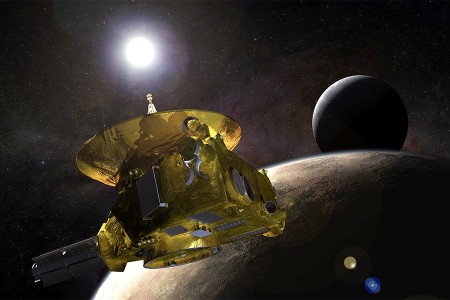February 7, 2016 – In 2020 if all goes according to plan NASA will introduce the first integrated-photonic modem, a device the size of a cell phone that incorporates lasers and fiber optics into integrated circuitry. The end result will be a dramatic increase in the speed of data and voice transmission. We are talking about rates 10 to 100 times faster than those found in today’s high-speed telecommunications equipment. At the same time this new modem will be a fraction of the size and require far less power than conventional technology. Called the Laser Communications Relay Demonstration or LCRD, it will be deployed and tested on the International Space Station (ISS). The device on ISS will interact with a ground-based station that NASA expects to have completed by 2019.
In all robotic spacecraft sent into orbit and beyond since the dawn of the Space Age, radio waves represented the means by which we sent and received data and images. When New Horizons arrived at Pluto it had the same technology on board as those first planetary explorers with little in the way of new innovation. A twist for New Horizons included two wave tube amplifiers known as “twitters,” not to be confused with the social media Twitter. This twinning of amplifiers improved radio communications being broadcast back to Earth.
Each New Horizons’ image was stored on a 32 Gigabyte hard drive and then transmitted back to Earth taking 4.5 hours to reach radio telescopes down here. The average image download took an additional 42 minutes. In the eight-hour window available to our Earth-bound radio telescopes that meant we could receive 11 images per session. Hence it will be some time before we see and read all that New Horizons collected, taking the better part of the rest of 2016.
With integrated photonics, using light rather than electrons to transmit data and images, NASA will receive flight data, video and still images at much faster rates. This will open up neighbouring worlds of the Solar System to much greater analysis. For example we will be able to track storms on Mars, Jupiter and Saturn the same way we follow hurricanes and typhoons here on Earth today. And integrated photonics will play as significant a role here on Earth impacting telecommunications, medical imaging, manufacturing and the military.
The precursor to LCRD was aboard the Lunar Atmoshpere and Dust Environment Explorer (LADEE) when it was launched in 2013. At that time NASA demonstrated data transmission using pulsed laser beams to transmit between the Moon and Earth at rates of 622 Megabits per second (Mbps). Data uploads to the spacecraft were sent at 20 Mbps. That successful demonstration was a proof of concept.
















